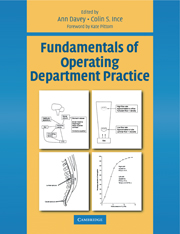Book contents
- Frontmatter
- Contents
- Contributors
- Preface
- Foreword
- Acknowledgements
- Introduction
- Chapter 1 The operating department practitioner, the patient and the law
- Chapter 2 Aspects of health and safety in the operating department
- Chapter 3 The caring practitioner
- Chapter 4 Strategies for infection control in the operating department
- Chapter 5 Sterilization, decontamination and the surgical field
- Chapter 6 The fundamentals of cardiovascular physiology
- Chapter 7 Fundamentals of respiratory physiology
- Chapter 8 Scientific principles in relation to the anaesthetic machine
- Chapter 9 Fundamentals of artificial ventilation of the lung
- Chapter 10 Scientific principles in relation to monitoring equipment
- Chapter 11 Scientific principles in relation to endoscopic, laser and radiological equipment
- Chapter 12 Pharmacological principles of drug administration
- Chapter 13 The pharmacology of drugs used in general anaesthesia
- Chapter 14 The local anaesthetic drugs - does the ideal agent exist?
- Chapter 15 The safe positioning of patients for surgery
- Chapter 16 Principles involved in the management and use of equipment
- Chapter 17 Understanding suture materials
- Chapter 18 Fundamentals ofpaediatric surgery and anaesthesia
- Chapter 19 Fundamentals of hyperthermia and hypothermia
- Chapter 20 Fundamentals of fluid and electrolyte balance during surgery
- Chapter 21 The physiology of blood and its administration
- Chapter 22 Fundamentals of pain relief
- Chapter 23 Fundamentals of dressings and drains in relation to wound healing
- Chapter 24 The recovery of patients from anaesthesia and surgery
- Chapter 25 Fundamentals of emergency and obstetric anaesthesia
- Chapter 26 Identification and management of anaesthetic emergencies
- Chapter 27 The fundamentals of emergency resuscitation
- Appendixes
- Index
Chapter 11 - Scientific principles in relation to endoscopic, laser and radiological equipment
Published online by Cambridge University Press: 05 October 2015
- Frontmatter
- Contents
- Contributors
- Preface
- Foreword
- Acknowledgements
- Introduction
- Chapter 1 The operating department practitioner, the patient and the law
- Chapter 2 Aspects of health and safety in the operating department
- Chapter 3 The caring practitioner
- Chapter 4 Strategies for infection control in the operating department
- Chapter 5 Sterilization, decontamination and the surgical field
- Chapter 6 The fundamentals of cardiovascular physiology
- Chapter 7 Fundamentals of respiratory physiology
- Chapter 8 Scientific principles in relation to the anaesthetic machine
- Chapter 9 Fundamentals of artificial ventilation of the lung
- Chapter 10 Scientific principles in relation to monitoring equipment
- Chapter 11 Scientific principles in relation to endoscopic, laser and radiological equipment
- Chapter 12 Pharmacological principles of drug administration
- Chapter 13 The pharmacology of drugs used in general anaesthesia
- Chapter 14 The local anaesthetic drugs - does the ideal agent exist?
- Chapter 15 The safe positioning of patients for surgery
- Chapter 16 Principles involved in the management and use of equipment
- Chapter 17 Understanding suture materials
- Chapter 18 Fundamentals ofpaediatric surgery and anaesthesia
- Chapter 19 Fundamentals of hyperthermia and hypothermia
- Chapter 20 Fundamentals of fluid and electrolyte balance during surgery
- Chapter 21 The physiology of blood and its administration
- Chapter 22 Fundamentals of pain relief
- Chapter 23 Fundamentals of dressings and drains in relation to wound healing
- Chapter 24 The recovery of patients from anaesthesia and surgery
- Chapter 25 Fundamentals of emergency and obstetric anaesthesia
- Chapter 26 Identification and management of anaesthetic emergencies
- Chapter 27 The fundamentals of emergency resuscitation
- Appendixes
- Index
Summary
INTRODUCTION
Endoscopes, lasers and radiological equipment all utilize the harnessing and manipulation of the physical properties of the electromagnetic spectrum, especially light. Although they have become commonplace in operating theatres, the rapid development of technology in the latter part of this century has greatly increased the scope of surgical practice. Most of this technology has been developed in other fields and then adapted for medical use later. In practice, the application of such technology greatly improves surgical technique and allows much more information to be gathered and utilized by the operation of ever more sophisticated hardware. The rapid increase in its use has not only had the benefit of safer and more successful surgery but has also expanded the range of procedures available. A more recent consideration is the trend towards less invasive and non-invasive surgery where such technology, although initially very expensive, can greatly benefit patients by involving them in less trauma and thus decreasing the time spent in hospital. This also reduces the cost of treatment.
THE ELECTROMAGNETIC SPECTRUM
Having briefly placed these particular tools into context as far as their use in surgery is concerned, we can now examine the underlying scientific and technological principles involved in their use.
To fully appreciate the fundamentals of the electromagnetic spectrum we must understand a little about particle physics, quantum theory and the theory of special relativity. Although the in-depth examination of these subjects is essential to the pure physicist it can be a little daunting to those of us who merely use the technology. However, if we are to understand how these tools work it is first important to examine the behaviour and characteristics of light. Light is the medium by which visual information about the universe is transmitted via the eye to the brain. This is what we all know and experience as visual light but it occupies only a small area within the spectrum of electromagnetic energy (Fig. 11.1).
Information
- Type
- Chapter
- Information
- Fundamentals of Operating Department Practice , pp. 121 - 132Publisher: Cambridge University PressPrint publication year: 1999
